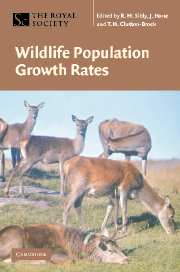Book contents
- Frontmatter
- Contents
- List of contributors
- 1 Introduction to wildlife population growth rates
- 2 Population growth rate and its determinants: an overview
- 3 Demographic, mechanistic and density-dependent determinants of population growth rate: a case study in an avian predator
- 4 Estimating density dependence in time-series of age-structured populations
- 5 Pattern of variation in avian population growth rates
- 6 Determinants of human population growth
- 7 Two complementary paradigms for analysing population dynamics
- 8 Complex numerical responses to top-down and bottom-up processes in vertebrate populations
- 9 The numerical response: rate of increase and food limitation in herbivores and predators
- 10 Populations in variable environments: the effect of variability in a species' primary resource
- 11 Trophic interactions and population growth rates: describing patterns and identifying mechanisms
- 12 Behavioural models of population growth rates: implications for conservation and prediction
- 13 Comparative ungulate dynamics: the devil is in the detail
- 14 Population growth rate as a basis for ecological risk assessment of toxic chemicals
- 15 Population growth rates: issues and an application
- References
- Glossary of abbreviations
- Author index
- Subject index
7 - Two complementary paradigms for analysing population dynamics
Published online by Cambridge University Press: 20 May 2010
- Frontmatter
- Contents
- List of contributors
- 1 Introduction to wildlife population growth rates
- 2 Population growth rate and its determinants: an overview
- 3 Demographic, mechanistic and density-dependent determinants of population growth rate: a case study in an avian predator
- 4 Estimating density dependence in time-series of age-structured populations
- 5 Pattern of variation in avian population growth rates
- 6 Determinants of human population growth
- 7 Two complementary paradigms for analysing population dynamics
- 8 Complex numerical responses to top-down and bottom-up processes in vertebrate populations
- 9 The numerical response: rate of increase and food limitation in herbivores and predators
- 10 Populations in variable environments: the effect of variability in a species' primary resource
- 11 Trophic interactions and population growth rates: describing patterns and identifying mechanisms
- 12 Behavioural models of population growth rates: implications for conservation and prediction
- 13 Comparative ungulate dynamics: the devil is in the detail
- 14 Population growth rate as a basis for ecological risk assessment of toxic chemicals
- 15 Population growth rates: issues and an application
- References
- Glossary of abbreviations
- Author index
- Subject index
Summary
Introduction
For more than 100 years, ecologists have been estimating populations of animals, beginning with those of economic value, and have tried to make sense of the resulting data. How to make sense of quantitative population data is not immediately clear. Once an ecologist has two successive estimates of population size, he or she follows the first law of quantitative ecology, which is to divide one number by the other, producing the finite population growth rate (λ) that Sibly & Hone (Chapter 2) described. However, what to do next?
This is the critical step. Being good scientists, most ecologists would wish to predict the size of the population growth rate and would proceed in one of two directions to do this. First, they could adopt the density paradigm of Sibly & Hone (Chapter 2) and plot population growth rate against population density. (The concept of a paradigm as promulgated by Thomas Kuhn (1970) has been used in many ways, and one might argue that the paradigms discussed here are better labelled as ‘conceptual approaches’. I have no quarrel with this comment and I use the term ‘paradigm’ as shorthand for what ecologists do (cf. den Boer & Reddingius (1996).) Alternatively, they could adopt the mechanistic paradigm and plot population growth rate against an ecological factor, such as the amount of food available per capita, which may explain the change. What are the problems and what are the advantages of going in one direction rather than another?
- Type
- Chapter
- Information
- Wildlife Population Growth Rates , pp. 110 - 126Publisher: Cambridge University PressPrint publication year: 2003
- 8
- Cited by

